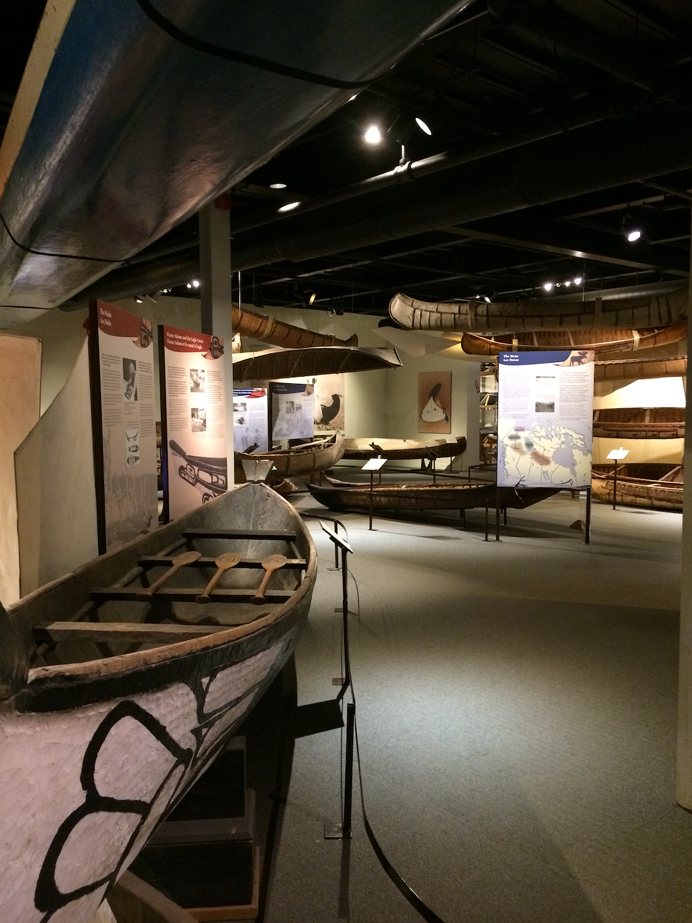The Department of Art History's Social Media Intern, Laura Lamont, had a busy year writing many feature stories for the department before social distancing measures and campus closures were in place. We will be sharing these features with you over the next few months and thank Laura for her dedication and hard work over the year. For her first feature, Laura had an opportunity to visit The Canadian Canoe Museum before temporarily closing its doors to help prevent the spread of COVID-19. Laura provides us with a brief glimpse of the museum and how it lives up to its motto of inspiring connection, curiosity and new understanding. #MuseumAtHome
The Canadian Canoe Museum is located in Peterborough Ontario, a small city just a couple of hours away from Toronto. Peterborough lies on the traditional territory of the Michi Saagiig Anishinaabeg, and is surrounded by a chain of lakes known as the Kawartha Lakes. Water transport has a long-established history in the area, and the museum focuses on the different origins, uses, and experiences of canoes and the people who use them across Canada. The museum holds over 600 paddled watercrafts today, representing many different aspects of our history.
The Canadian Canoe Museum has a natural chronological flow to it. Entering the building, you are instructed to head up the stairs to the “origins” gallery. This gallery focuses on canoes and kayaks as an Indigenous technology which uses adapted materials. One of the most beautiful boats on this floor is the Eagle Canoe, a Haida dugout canoe built by Victor Adams in 1971. It is 6.96m (22’10”) long and 1.04m (3’5”) across and built out of a single cedar log. As you walk through the room, there are many different explanatory methods including videos, stories emphasizing the importance of canoes, and signposts. This section also discusses the use of kayaks in the Arctic as a hunting craft. Moving on, the museum has a section on preservation. This is rather sparse, but conservation efforts are explained on signs around the museum. This leads into a section on trade and colonization. This section is perhaps a little smaller and focuses largely on the appropriation of canoe technologies by voyageurs as well as the different forms of survival such as a reliance on pemmican (a nutritious and long-lasting food high in fat and protein). There is a surprising amount of interaction in this museum. Visitors can feel different materials such as birch bark and furs, enter replicas of a Mi’kmaq winter camp or a voyageur tent, and towards the end there is even a suspended canoe into which visitors are allowed to climb to experience the feeling of being in a canoe.

The lower floor continues this journey through time to the present uses of canoes, starting with the fur trade. It begins in a replica room of a trading post with furs you can touch and explanations of the importance of canoes for the Geological Survey of Canada in 1842. After this it moves on to the use of canoes for recreational activities, the history of paddling in the Olympics, and the industry around canoes.

One of the more interesting aspects of the museum is actually the history of the museum itself. The final section of the Canoe Museum discusses the life of Kirk Wipper, the founder of the museum. The museum was started by Wipper, a professor of Physical Education at the University of Toronto. In the 1950s, Wipper started a collection of canoes at a summer camp where he served as the director during the summers. The collection lived at this summer camp until 1995, when a former outboard motor factory was purchased to house the museum and where it remains today. Due to the nature of the building as a repurposed factory, the two floors of the museum feel quite disconnected. Since 1997, this building has been considered interim. Finally, a new and more energy efficient building is on the horizon. The new building will be purpose-built and situated beside Peterborough’s famous liftlock, providing it access to the water. Even with the anticipated new building, the current space is worth a visit. The improvised quality of the building in an old factory even adds to its charm in a way, as the boats really speak for themselves.
The Canadian Canoe Museum is in Peterborough, Ontario and is normally open Monday-Wednesday and Friday-Saturday from 10am-5pm, Thursdays from 10am-8pm, and Sundays 12:00-5pm. The museum is also free on Thursdays from 5pm-8pm.
Please visit the museum’s website for more information and special events.
Please note that the Canoe Museum is currently temporarily closed due to COVID-19. Please check the website for a message from the Executive Director and Chair of the Board of Directors.


